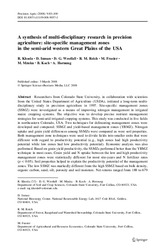| dc.contributor.author | Khosla, R. | |
| dc.contributor.author | Inman, D. | |
| dc.contributor.author | Westfall, D. G. | |
| dc.contributor.author | Reich, R.M. | |
| dc.contributor.author | Frasier, M. | |
| dc.contributor.author | Mzuku, M. | |
| dc.contributor.author | Koch, B. | |
| dc.contributor.author | Hornung, A. | |
| dc.date.accessioned | 2021-03-29T09:14:22Z | |
| dc.date.available | 2021-03-29T09:14:22Z | |
| dc.date.issued | 2008-03-03 | |
| dc.identifier.citation | Khosla, R., Inman, D., Westfall, D. G., Reich, R. M., Frasier, M., Mzuku, M., ... & Hornung, A. (2008). A synthesis of multi-disciplinary research in precision agriculture: Site-specific management zones in the semi-arid western Great Plains of the USA. Precision Agriculture, 9(1), 85-100. | en_US |
| dc.identifier.issn | 1573-1618 | |
| dc.identifier.uri | https://link.springer.com/article/10.1007/s11119-008-9057-1 | |
| dc.identifier.uri | http://moodle.buan.ac.bw:80/handle/123456789/25 | |
| dc.description.abstract | Researchers from Colorado State University, in collaboration with scientists from the United States Department of Agriculture (USDA), initiated a long-term multi-disciplinary study in precision agriculture in 1997. Site-specific management zones (SSMZ) were investigated as a means of improving nitrogen management in irrigated maize cropping systems. The objective was to develop precise nutrient management strategies for semi-arid irrigated cropping systems. This study was conducted in five fields in northeastern Colorado, USA. Two techniques for delineating management zones were developed and compared: SSMZ and yield-based management zones (YBMZ). Nitrogen uptake and grain yield differences among SSMZs were compared as were soil properties. Both management zone techniques were used to divide fields into smaller units that were different with regard to productivity potential (e.g., high zones had high productivity potential while low zones had low productivity potential). Economic analysis was also performed. Based on grain yield productivity, the SSMZs performed better than the YBMZ technique in most cases. Grain yield and N uptake between the low and high productivity management zones were statistically different for most site-years and N fertilizer rates (p < 0.05). Soil properties helped to explain the productivity potential of the management zones. The low SSMZ was markedly different from the high SSMZ based on bulk density, organic carbon, sand, silt, porosity and soil moisture. Net returns ranged from 188 to 679 USD ha−1. In two out of three site-years the variable yield goal strategy resulted in the largest net returns. In this study, the SSMZ approach delineates areas of different productivity accurately across the agricultural fields. The SSMZs are different with regard to soil properties as well as grain yield and N uptake. Site-specific management zones are an inexpensive and pragmatic approach to precise N management in irrigated maize. | en_US |
| dc.language.iso | en | en_US |
| dc.publisher | Springer Link | en_US |
| dc.relation.ispartofseries | Precision Agriculture;Vol. 9 (1), 2008, 85-100 | |
| dc.subject | precision agriculture | en_US |
| dc.subject | site-specific management zones | en_US |
| dc.subject | semi-arid | en_US |
| dc.subject | Great Plains of the USA | en_US |
| dc.title | A synthesis of multi-disciplinary research in precision agriculture: site-specific management zones in the semi-arid western Great Plains of the USA | en_US |
| dc.type | Article | en_US |

